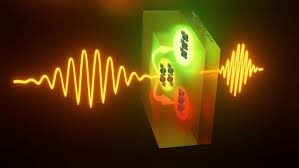Terahertz Pulses Have Broken the Speed Barrier for Magnetic Data Reading
The electric field of the incoming terahertz pulse induces rapidly oscillating currents in the metal film. The spin Hall effect then segregates electrons based on their spin orientation, altering the sample's electrical properties according to the film's magnetization, symbolized by the compass needles. This interaction imprints a distinct signature on the frequency spectrum of the emitted terahertz beam.

Figure 1.Magnetic Data Reading.
Ultrafast Magnetic Data Reading with Terahertz Radiation
Scientists have developed a groundbreaking method to read magnetic orientation at unprecedented speeds using terahertz radiation. Traditional hard drives rely on magnetic structures, but their transfer speeds are limited. Researchers from HZDR and TU Dortmund University have now achieved a breakthrough by using ultrafast terahertz pulses instead of electrical pulses, enabling magnetic data reading within picoseconds. Their study, published in Nature Communications, paves the way for high-speed data storage and retrieval. Magnetic data reading shown in figure 1.
Decoding Magnetization with Light
Dr. Jan-Christoph Deinert from HZDR’s Institute of Radiation Physics explains that light-induced current pulses now enable much faster determination of magnetic orientation [1]. The team utilized terahertz radiation, which lies between infrared and microwave frequencies, generating ultrashort pulses with the ELBE radiation source at HZDR. These pulses effectively analyze the magnetization of ultra-thin material samples.
The tested materials consisted of two stacked layers, only a few nanometers thick. The lower layer was magnetic (e.g., cobalt or iron-nickel alloy), while the upper layer consisted of metals like platinum, tantalum, or tungsten. Due to their minimal thickness, only part of the terahertz radiation penetrates the layers, a crucial factor in detecting the magnetization of the lower layer.
Complex Quantum Effects in Simple Materials
Dr. Ruslan Salikhov from HZDR explains that terahertz pulses create intricate light-matter interactions, revealing rapid quantum effects. These pulses generate short-lived currents, aligning electrons by spin and producing a spin current. At the interface, electron accumulation alters electrical resistance based on magnetization, a phenomenon called unidirectional spin Hall magnetoresistance (USMR). Originally discovered at ETH Zurich, the HZDR and TU Dortmund team has now advanced this effect, enabling trillion-per-second spin current shifts and ultrafast magnetization reading through terahertz pulses.
Ultrahigh-Speed Magnetization Detection
Dr. Sergey Kovalev from TU Dortmund University explains that magnetization direction influences the sample’s transparency, modifying terahertz pulses [2]. After passing through the material, the pulses oscillate at twice their original frequency (second harmonic generation), allowing precise magnetization detection within picoseconds.
Towards Next-Generation Magnetic Memory
Researchers are now exploring terahertz radiation not only for reading but also for writing magnetic data. However, practical implementation will take time, requiring more compact terahertz sources and efficient detection methods. Nevertheless, the ultrafast USMR effect reveals the potential of simple material systems in shaping the future of high-speed magnetic memory.
Reference
- https://scitechdaily.com/terahertz-pulses-just-shattered-the-speed-limit-for-magnetic-data-reading/
- https://www.nature.com/articles/s41467-025-57432-2.
Cite this article:
Keerthana S (2025),Terahertz Pulses Have Broken the Speed Barrier for Magnetic Data Reading, AnaTechMaz,pp.114















